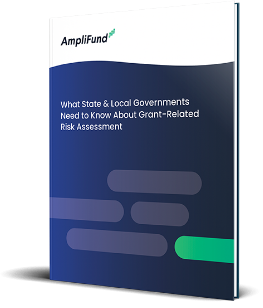In downstream grant ecosystems, not every recipient will have a grant management system in place, standardized ways to collect financial data from subrecipients, or secure and reliable methods for processing payments. This challenge can often result in administrative burden when monitoring compliance, managing payment requests, and can contribute to a loss of resources that could have been allocated toward improving outcomes.
Rising to the Challenge
The President’s Management Agenda (PMA), published in March 2018, set out to address this challenge. By establishing Cross Agency Priority (CAP) Goal #8, Results Oriented Accountability for Grants, the Federal government sought to “improve data collection in ways that will increase efficiency, promote evaluation, reduce reporting burden, and benefit the American taxpayer.”
According to the PMA, Grant Managers reported spending up to 40% of their time using antiquated processes to monitor compliance. CAP Goal #8 was established to “identify, open, standardize, and link critical data sets” in order to “enhance financial stewardship” and performance management to address this unbalanced time allocation. One method proposed for accomplishing this goal was using digital tools to modernize antiquated form-based compliance processes.
AmpliFund has worked with MITRE, a nonprofit research and development organization, in a pilot project to better understand how blockchain technology may be able to help reduce administrative burden for grant management. Through this relationship, we have gained insight into the ways that blockchain technology could improve transparency in grant management. We have previously discussed how blockchain could function in the grant management space, and how it could realistically affect auditing in the future. But, could it influence the way we currently manage payment requests?
How it Works
With blockchain, a technology that records transactions into a digital, distributed ledger, a record of each transaction is recorded and updated at every point in the chain of users who are involved with a financial transaction. The history of these transactions can neither be modified nor deleted. They may only be added to and never edited. MITRE has previously conducted studies to identify how blockchain technology could potentially enhance security and improve transparency at the Federal level due to the way that financial information could be easily accessed on the blockchain by anyone who has the proper permissions to view it in the grant lifecycle.
Further, all transactions are linked with blockchain, meaning that if you change any element of a current or future transaction, that change must carry through to every end point. The result of this is that no one user can make a change that could break the chain, and therefore, no fraudulent or otherwise unagreed-to transactions can occur; allowing for a more accurate, secure transmission of data and payments across multiple tiers and consistent records of financial transactions.
Federal grants move funds through multiple tiers of recipients and subrecipients, and because of blockchain’s ability to create permanent records of financial transactions that must be reconciled to be entered into the chain, this technology could be one potential solution.
Payments & Reconciliation
Grant management software systems already drive efficiencies in reporting practices and help to ensure that payment reconciliation is accurate and timely. Blockchain could help further streamline these processes in the future because of the ability to reconcile payments between the prime recipient, the Federal Payment Management Service, and the Federal Awarding Agency, all of which could benefit from the transparency of the obligated costs of each entity in the grant chain.
Practically, this transparency could allow for an increased capacity to quickly allocate funds directly to those incurring direct costs – prime or subrecipient – by auto-calculating the amount needed for indirect cost, and subsequently paying accordingly. Subrecipients of a Federal award may not be as dependent on the performance or timeliness of other subrecipients of the pass-through entity to receive payment, as payments could be allocated in a way that cannot be done today.
Ultimately, the future of payment management may have dramatically reduced administrative burden, a more time-efficient way for recipients to get access to funds, and more comprehensive data sets for the Federal Awarding Agency to aggregate and assess outcomes.
The increased transparency and greater data sets created in the process could pave the way for a faster deployment of funds for local initiatives, and a more effective Federal investment approach overall.
Digital tools help ensure that financial data is very unlikely to be compromised during the movement and approval between layers of multiple tiers. Blockchain will most likely change the way payments are processed in the future, but you can begin to achieve financial fidelity for your organization today by adopting a grant management system.





